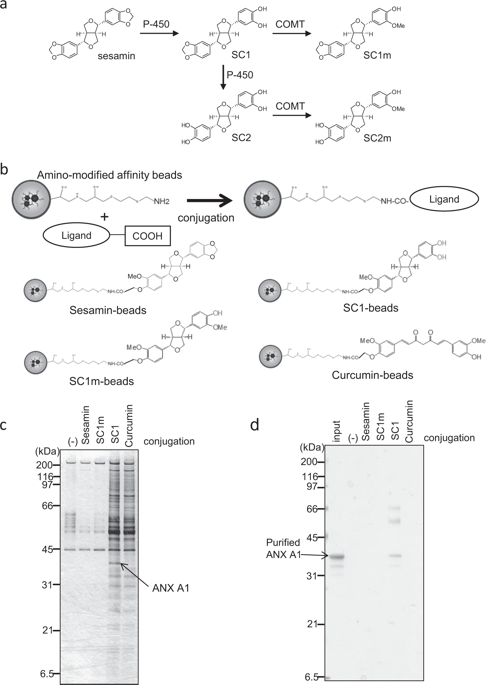npj Science of Food ( IF 6.4 ) Pub Date : 2020-02-20 , DOI: 10.1038/s41538-020-0064-6 Yasuaki Kabe , Daisuke Takemoto , Ayaka Kanai , Miwa Hirai , Yoshiko Ono , Sota Akazawa , Manabu Horikawa , Yoshinori Kitagawa , Hiroshi Handa , Tomohiro Rogi , Hiroshi Shibata , Makoto Suematsu

|
Sesamin [(7α,7′α,8α,8′α)-3,4:3′,4′-bis(methylenedioxy)-7,9′:7′,9-diepoxylignane] is a major lignan in sesame seeds. Sesamin is converted to the catechol metabolite, SC1 [(7α,7′α,8α,8′α)-3′,4′-methylenedioxy-7,9′:7′,9-diepoxylignane-3,4-diol] with anti-inflammatory effects after oral administration. However, its molecular target remains unknown. Analysis using high-performance affinity nanobeads led to the identification of annexin A1 (ANX A1) as an SC1-binding protein. SC1 was found to bind to the annexin repeat 3 region of ANX A1 with a high-affinity constant (Kd = 2.77 μmol L−1). In U937 cells, SC1 exhibited an anti-inflammatory effect dependent on ANX A1. Furthermore, administration of sesamin or SC1 attenuated carbon tetrachloride-induced liver damage in mice and concurrently suppressed inflammatory responses dependent on ANX A1. The mechanism involved SC1-induced ANX A1 phosphorylation at serine 27 that facilitates extracellular ANX A1 release. Consequently, the ANX A1 released into the extracellular space suppressed the production of tumor necrosis factor α. This study demonstrates that ANX A1 acts as a pivotal target of sesamin metabolites to attenuate inflammatory responses.
中文翻译:

Annexin A1是芝麻素代谢产物的抗炎结合靶点
芝麻素[(7α,7'α,8α,8'α)-3,4:3',4'-双(亚甲基二氧基)-7,9':7',9-二环氧木烷]是芝麻中的主要木酚素。 。芝麻素被转化为邻苯二酚代谢产物SC1 [(7α,7'α,8α,8'α)-3',4'-亚甲基二氧基-7,9':7',9-双环氧木烷-3,4-二醇]口服后具有抗炎作用。然而,其分子靶标仍然未知。使用高性能亲和力纳米珠进行的分析导致鉴定出膜联蛋白A1(ANX A1)为SC1结合蛋白。发现SC1以高亲和力常数(Kd = 2.77μmolL -1)与ANX A1的膜联蛋白重复3区域结合)。在U937细胞中,SC1表现出依赖于ANX A1的抗炎作用。此外,芝麻素或SC1的施用减轻了小鼠四氯化碳诱导的肝损伤,并同时抑制了依赖于ANX A1的炎症反应。该机制涉及在丝氨酸27处SC1诱导的ANX A1磷酸化,促进细胞外ANX A1的释放。因此,释放到细胞外空间的ANX A1抑制了肿瘤坏死因子α的产生。这项研究表明,ANX A1作为芝麻素代谢产物的关键靶点,可减轻炎症反应。

























 京公网安备 11010802027423号
京公网安备 11010802027423号